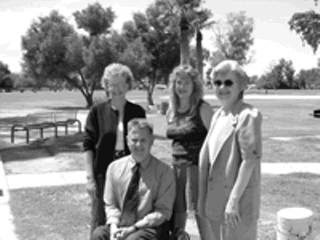Tell me a little bit about this project.
In 2005, Rotary International, which is an international service club made up of professionals and people from the community, is going to be celebrating its 100th birthday. There are thousands of clubs across the United States and the world. In order to commemorate the 100th year of providing service, Rotary International has suggested that each one of its member clubs think of a centennial project that would leave a lasting legacy in their own communities. We have selected as our centennial project the construction of a universally accessible playground for all of Tucson's children, regardless of their abilities. This will contain specific and special accommodations to help children with disabilities, whether they're physical or developmental or sensory--in other words, if they're hearing impaired or if they're blind or if they have a developmental disorder or if they have a physical limitation--(to) participate alongside of their typically developing peers in a play setting.
Where did the idea for this come from?
This is a relatively new idea. For many years, the Americans with Disabilities Act has been trying to make people think about making everything more accessible to people with disabilities. But in the last five years, there has been a real movement away from just helping just get there. É. There's a nonprofit called Boundless Playgrounds that's located in Connecticut that has started a movement to create playgrounds that go far beyond the ADA requirements and open playgrounds to all children (that) are so exciting that children with normally developing skills couldn't wait to get on them and play, too. And that's the neat part about this: It's a playground that very inclusive, that allows children with disabilities to get on and play and enjoy the same type of things right alongside normally developing peers.
So what's the playground all about?
Traditional playgrounds gave you what's called "transfer stations"--some place you could go up to and then pull yourself up from your wheelchair, if you were in one, and there you were--and where do you go from there? But this particular playground gives you a whole ramped environment so people can get up on the structure, and they can move around from place to place. It's looped, so you don't just go up and then turn around and come back, but you keep going. It has different modules so they'll come to different exploration stations; they'll come to different learning areas. It's very multi-sensory, with lots of different ways to engage all of their senses, whether it's touch or vision or listening, and certainly movement is a big part of it.
Who's involved with this?
We looked around in all of the different wards in this city for a place to put this park, and in Ward 3, we found not only a park, but also a council member in Kathleen Dunbar and her aides, who were absolutely as excited about this project as we were. And they have come together with us to form a private-public partnership. So what we're doing with that as a basis is going out and meeting with many different groups--teachers, educators, youth advisory groups of children who have disabilities. We have lots of input from the disabled community. And the Flowing Wells Neighborhood Association, when (it) learned that this type of thing can come to their park in their neighborhood, has also joined us as a very active partner. So we're hoping that by the time two years roll by, and we have gathered all these resources together, we have something we can leave to Tucson as a tremendous legacy and a model of what a universally accessible playground can be for all children.
What needs to happen in terms of fund-raising?
We're shooting for $300,000. We already have $150,000 committed, so we're looking for people who would join with us to help us bridge that gap. We're writing grants to different agencies, we've already have people come forward and say they can help with the landscaping, that they'd love to help with X, Y and Z. It's been amazing how many people have come forward just knowing what this project is all about.
Who else is helping out?
We have a landscape architect in our club, Anne Warner, who is with a company called Planning Resources. And she is doing the plan, pro bono, and she's also involving the students at the University of Arizona in the Landscape Architecture Department.
Where else has this been done?
There are about 20 of these playgrounds in the United States. A very famous one is in Griffith Park in Los Angeles. It's an amazing playground. It's one of the few that's in the West. Most of the playgrounds that have been developed so far have been in the East. There's nothing like this in Arizona.









